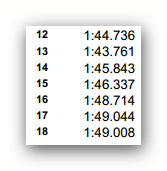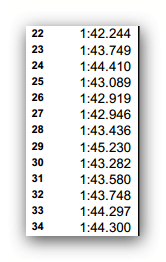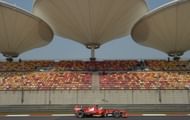The Chinese Grand Prix weekend got underway today and it was the Mercedes duo of Nico Rosberg and Lewis Hamilton who topped the timesheets during the first practice session, while in the second practice as the track rubbered in, the Ferrari‘s and Lotus came into contention and in the end it was Felipe Massa who topped the second practice session. Since the fastest times on Friday don’t really show the true picture, let’s take a deeper look into the two practice sessions.
Short Run Pace Analysis:
Note: For the analysis, we are taking into account the times from the second practice session because during first practice the track is dirty and green and so the cars don’t run at their maximum potential. It’s only when some rubber gets laid down that the cars can run to their maximum potential.
As far as the short run one lap pace is concerned, the Mercedes and the Red-Bull look to be the quickest.
Though in second practice it was the Ferrari of Felipe Massa and the Lotus of Kimi Raikkonen on top, the Mercedes could have the topped the timesheets had they gone bit late in the session for their Qualifying simulation runs, when the track had rubbered in. Likewise for Red-Bull, Mark Webber was one of the first guys to switch on to the softer compound and so there was more raw pace in the Red-Bull.
Ferrari and Lotus also look quick but over one lap pace it’s unlikely that they will be challenging the likes of Mercedes and Red-Bull for pole position and are likely to end up just outside the top 3 positions on the racing grid, come the Saturday qualifying.
Coming to the other teams, Force India looks the best of the rest with Mclaren close behind them. While in the midfield, there is going to be a big scrap between the Sauber, Williams and Toro Rosso cars to get through the first leg of qualifying. Jules Bianchi again looked impressive in his Marussia and his fastest time was only five tenths away from the fastest time set by the Williams duo of Vlatteri Bottas and Pastor Maldanado.
As far as tyres are concerned, during the final shootout all the top runners are likely to set their fastest lap on their first run of the softer, yellow-walled Pirelli tyres. While in Q1 top teams like Mercedes and Red-Bull can take a gamble to make through into Q2 by using the harder compound medium tyre, all other teams are likely to use one set of softer, yellow-walled Pirellis to get through into Q2. In Q2, all the teams will have to use the softer compound Pirelli tyres to make through into Q3 and the final leg of shootout.
The most interesting session is likely to be Q2 because the softer compound Pirelli tyres are degrading at a very high rate and by the end of the first flying lap, all of the drivers saw a dip in the grip and performance offered by the softer tyre. So if anyone of the top runners has a messy lap, it could give some midfield runners the chance to make it into Q3.
Long Run Race Pace Analysis:
Long Run pace will be a matter of concern for all the teams in the paddock as there is a significant difference between the pace and grip offered by the softer and the harder Pirelli tyre compounds. The Harder medium tyre seems to be giving optimum performance and grip on longer runs, while the softer tyre is disintegrating just two to three laps into the long run. So, the most probable strategy will be to do as less laps as possible on the softer tyre and do the maximum amount of race distance on the harder medium compound tyre.
Now, we take a look at the long run laptimes of various drivers and teams on the softer and medium tyre compounds.
Mercedes:
Mercedes were one of the teams who started their long runs very early and did the maximum laps. Also, from the laptimes of their two drivers the difference between the two tyre compounds can be easily determined.
Nico Rosberg’s heavy fuel long run laptimes on softer tyre:
Nico Rosberg’s heavy fuel long run laptimes on medium tyre:
From the above statistics, it is quite clear that the medium tyre is the one to be on for the race as the softer tyre showed very significant dip in performance after just two laps into the run. The dip in performance of the softer tyre on the Mercedes was more than what it was on other teams’, because Mercedes were the first teams to do the long run simulation and at that time the track was still very green. But it gives an indication that the softer tyre will degrade very quickly and if teams do start the race on it, the first round of pitstops will likely be around lap 5 or 6.
Note: The lap-times you will see in the race will be quicker than what you see now because as more rubber gets laid on the track, the degradation will decrease and reliability and the performance of the tyres will increase.
Ferrari and Lotus:
The Ferrari F138 looks to be very consistent on long run pace and the tyre management of the Ferrari is better and more consistent than the Mercedes and Red-Bull. So, come the race, the Ferrari’s will be fighting for top positions on the podium.
Like Ferrari, Lotus also is very consistent with the tyres and both Ferrari and Lotus are likely to be the long runners in the race. But even with these two teams, the softer tyre degradation was quite significant.
Red-Bull:
The Red-Bull’s didn’t do too many consistent laps in the second practice so it’s difficult to judge their performance, but going by what happened in Australia and Malaysia, Red-Bull, like Mercedes, are likely to suffer more tyre degradation compared to Lotus and Ferrari. Another challenge for Red-Bull will be their straight-line speed as they were very slow through the third sector and were losing heaps of time there. So, in the race if they get involved in a scrap with other teams, the likelihood of other cars overtaking them on the long 1.2 km straight will be very high and possibly disastrous. So they will need to get a good qualifying and then break way from the pack to have a comfortable position in the race.
Other teams:
Force India and McLaren are likely to lead the charge of other remaining teams. McLaren, although in a better shape as compared to Australia, still haven’t got on top of their ride height and stability issues. So don’t expect them to be challenging the top runners and expect them to be involved in the midfield scrap with Force India, Sauber and possibly Williams.
Force India looked strong again and were consistent with their tyre usage so a top 10 finish is definitely on the cards for both of their drivers.
Strategy Options:
Strategy-wise, most of the top teams are likely to start the race on the softer compound tyre and then use the medium compounds for the rest of the race, while some teams at the back and in the midfield can opt to start the race with the medium tyre and then change to the softer tyre in the latter part of the Grand Prix.



